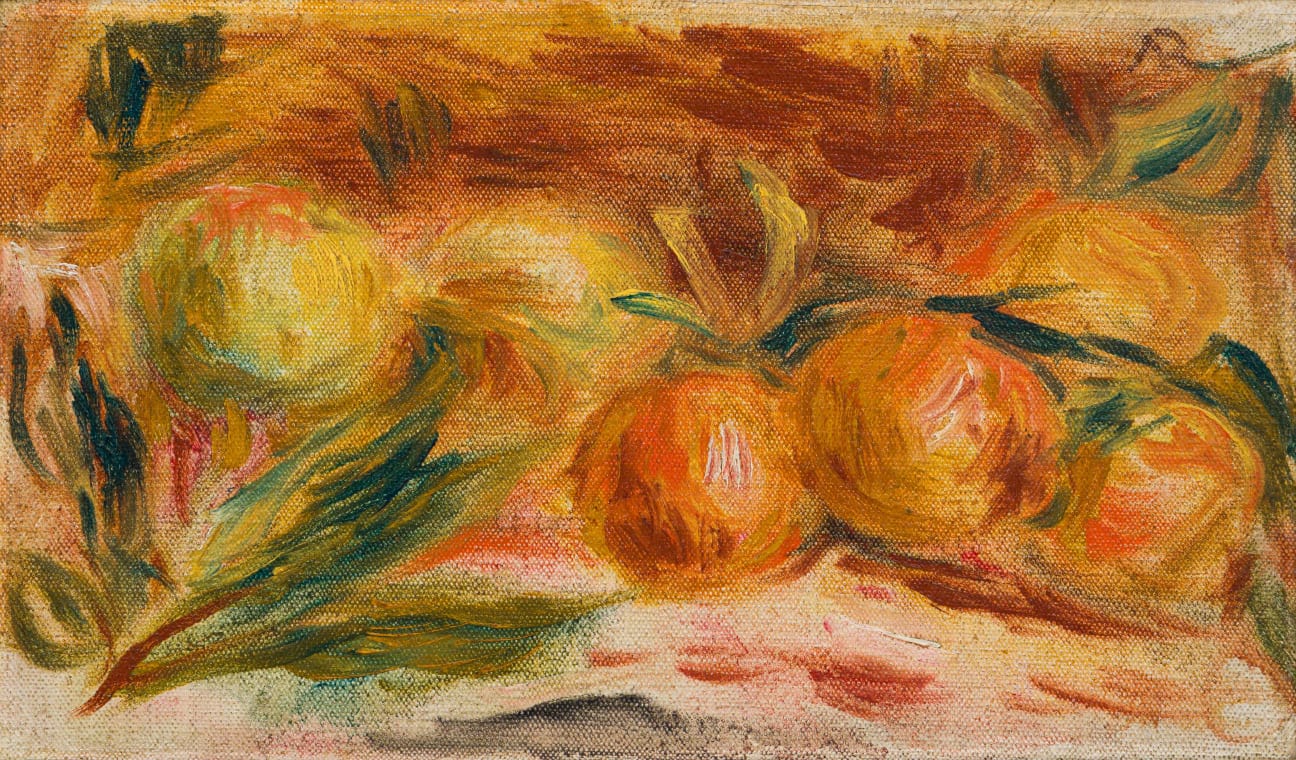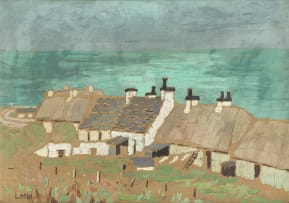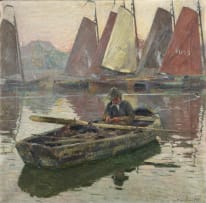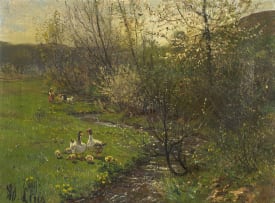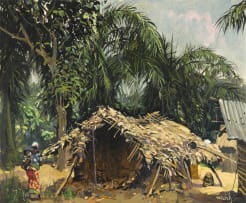Fruits (Oranges et Citrons)
Pierre-Auguste Renoir
Incl. Buyer's Premium & VAT
About this Item
signed; signed, dated 1912 and inscribed with the title on a label adhered to the reverse
Notes
The present lot is accompanied by a Wildenstein Plattner Institute letter of authenticity.
Pierre-Auguste Renoir was a leading figure in the Impressionist movement who left an indelible mark on art history with his distinctive style. Fruits: Oranges et Citrons is a late-career jewel. Painted in 1912, it captures the essence of Renoir's artistry, revealing how he sought beauty in the every day and created a sensory experience through his paintings. The lot is distinguished by a number of prominent features: short and vital brushstrokes, an emphasis on lush forms, and the painter's remarkable ability to capture light and fleeting movement.
Painted when Renoir was 71, the modest scale of the painting may be attributable to the artist's declining health. In 1894, Renoir had his first attack of rheumatism. The increasing frequency of these attacks prompted him to spend more time in southern France, where the climate was better for his health. From about 1899 he sought refuge in the small village of Cagnes-Sur-Mer, in the south of France, and in 1906 he settled there permanently, at his estate of Les Collettes. A serious attack of rheumatism in 1910 left the artist wheelchair bound for the rest of his life. An attempt to surgically address his illness in 1912 left him partially paralyzed, and Renoir was, at times, forced to bind his paintbrush to his hand. The present lot was likely painted within these restrictions.
Notwithstanding his health problems, Renoir continued to find joy in painting. His subject matter was largely his own family, staff on the farm, landscapes and fruit from the garden. During this period Renoir returned to his earlier use of explosive colours and compelling brushstrokes. Other notable works from this period include Seated Bather (1914), which, like the present lot, is of exceptional quality and 'characteristic of Renoir's late style, with its rich, invariably hot colour.'1 The fleshy rendering of the fruit in Fruits: Oranges et Citrons parallels Renoir's approach to capturing the human form, particularly that of young girls with plump cheeks in their innocence and fertility. Renoir's art aims to harmonize elements purposefully and embraces the plein air spirit. He channels the atmosphere of the moment, capturing life itself through the interplay of colour and light.
The subject of Fruits: Oranges et Citrons is citrus fruits typically associated with winter. Renoir's use of lush colours and unblended, rhythmic brushstrokes however transcends the mere representation of seasonal fruit. His painting exudes joy, and viewers can almost sense the zesty scent of the citrus emanating from the canvas. Renoir employs the complementary colours of blue and orange to portray two lemons, and red and green for the oranges. What sets the painting apart is Renoir's use of short brushstrokes capturing light and movement to trick the viewer into deducing the titular fruits. Renoir compels visual participation, inviting viewers to complete and finish the composition themselves.
Renoir worked at a time when the new technology of photography was impacting painters, notably their understanding of colour and light. New ideas related to light waves and prisms were prevalent, lending scientific credence to the Impressionists' practice of dashing paint onto canvases to capture the essence of a moment. The present lot is a perfect illustration of Renoir's particular brand of Impressionism. 'What seems to me most significant about our movement,' Renoir said in reference to Impressionism, 'is that we have freed painting from the importance of the subject. I am at liberty to paint flowers and call them simply flowers, without their needing to tell a story.'2
Renoir's commitment to the joy of painting is evident in Fruits: Oranges et Citrons, in particular his delight in rendering the essence of beauty in all aspects of life. His work radiates optimism, celebrating the pleasures of existence without delving into profound or sombre subjects. 'If painting were not a pleasure to me, I should certainly not do it,' Renoir told his art teacher, Swiss painter Charles Gleyre at the École des Beaux-Arts, early into his celebrated career.3 This lot, made seven years before his death, reveals the durability of this optimism. Renoir immortalizes the joy of citrus, inviting us to partake in the sensory experience. This painting serves as a window into Renoir's worldview, where the play of light, the fleeting moment, and the celebration of life take centre stage.
The provenance and authentication of Impressionist artworks, including those by Renoir, is key to their market presence. Fruits: Oranges et Citrons has a remarkable provenance, having been handled by Paul Durand-Ruel, the enormously influential French dealer and early supporter of Renoir, Claude Monet, and Camille Pissarro. The painting passed through his eponymous galleries in Paris and New York, before being acquired by a South African collector.
A crucial step in the authentication of works by Renoir is their presentation to the Wildenstein Plattner Institute (WPI), which Strauss & Co undertook as part of the necessary due diligence of authentication. Renoir, being a highly documented artist, must pass the WPI's meticulous evaluation process. Works are authenticated by reference to the artist's catalogue raisonné, a definitive record of Renoir's body of work. This archive is continuously updated to include new findings and discoveries, notably by a team of nine specialists who convene four times a year to examine and authenticate unpublished artworks for inclusion in the catalogue raisonné. This stringent authentication process ensures that any Renoir piece that successfully passes through it will carry a robust and irrefutable provenance. It has recently been authenticated by WPI and will be included in the upcoming catalogue raisonné on the artist's still life paintings.
Renoir was a prominent French artist celebrated for his Impressionist work. Born in Limoges to a modest family, he relocated to Paris in 1845. Despite financial constraints, Renoir nurtured dreams of becoming an artist. In 1869, he secured a spot at the École des Beaux-Arts, forming close friendships with fellow artists Claude Monet, Alfred Sisley, and Frederic Bazille. Initially, Renoir drew inspiration from Gustave's dark palette, gradually embracing Impressionism, which encouraged painting en plein air and focusing on light and form.
Renoir grappled with financial hardships until the late 1870s when his portrait of Madame Charpentier garnered acclaim. A fortuitous meeting with patron Paul Bérard further propelled his career. However, a creative crisis prompted him to reevaluate his artistic direction, aiming to meld French painter Jean-Auguste-Dominique Ingres' precision with the use of vibrant colours. In the late 1880s, Renoir's health deteriorated due to arthritis, yet his artistic spirit endured. In 1906, he settled in Cagnes-Sur-Mer in the south of France, where he ventured into sculpture with the assistance of others. His later works often featured solitary female figures, frequently painted directly from models. Renoir remains a beloved artist. His enchanting Impressionist paintings continue to captivate and inspire art enthusiasts worldwide.
1. John Rothenstein (1966) The Masters 21 - Renoir, United Kingdom: Knowledge Publications, page 8.
2. Ibid, page 3.
3. https://www.nationalgallery.org.uk/artists/pierre-auguste-renoir, accessed 17 September 2023.
Provenance
WJ Halvorsen, Paris.
Durand-Ruel, Paris, 1919.
Durand-Ruel, New York, 1921.
Jacques de Chollet, Lausanne.
Collectors Gallery, Rosebank, Johannesburg, 1977.
Private Collection, Benoni.
Private Collection, Pretoria.
Literature
This work will be included in the forthcoming Pierre-Auguste Renoir Digital Catalogue Raisonné, currently being prepared under the sponsorship of the Wildenstein Plattner Institute, Inc.
View all Pierre-Auguste Renoir lots for sale in this auction
